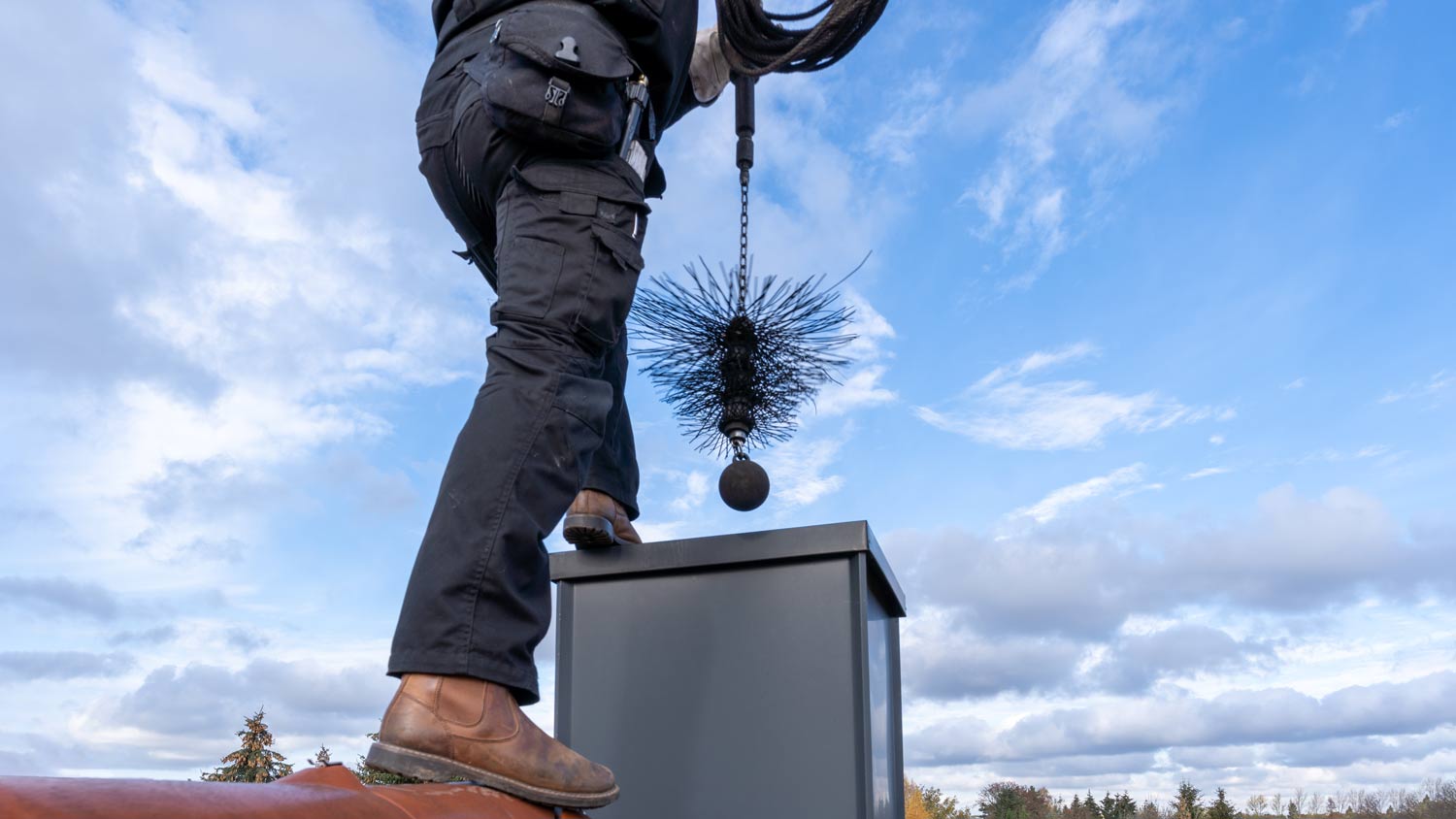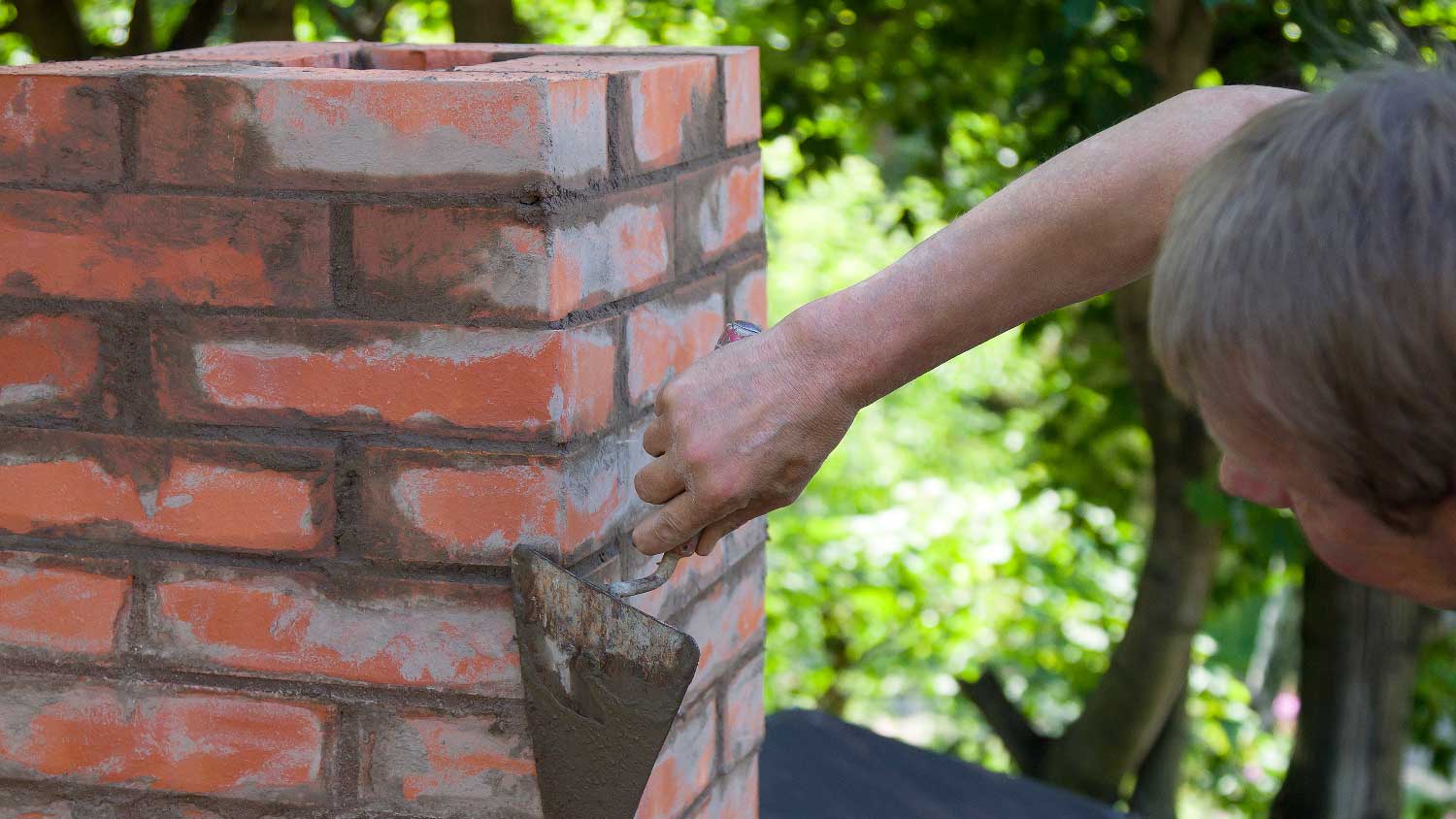
If you’re experiencing chimney airflow problems, a new damper may be in order. Use this guide to learn what goes into your chimney damper replacement cost.
When your chimney’s choked up, get out the big brush


If you’ve just lit a fire on a cold winter’s night only to start choking on the plumes of black smoke filling your living room, you could have a blocked chimney flue. This isn’t something to ignore in the hope that the flames will burn through the blockage. Clogged chimneys can spread harmful gasses, cover your furnishings in black soot, damage your chimney, and be a major home fire hazard.
Learning how to clear a blocked flue will help you decide if it’s doable to DIY. This task can be tricky and often involves working at heights. Here’s how to do it.

Clearing a blocked flue can be messy. Before you start, clear your fireplace and cover your flooring and furnishings around it with drop cloths or a tarp to save them from getting sooty.
If you’re attempting to clear from the top of the chimney, seal the fireplace entrance with a plastic sheet secured with duct tape. Wear protective goggles and a dust mask, so dislodged carbon particles don’t irritate your eyes or chest.
While you can dislodge some basic blockages with a long-handled broom, removing clogs far into tall chimneys often requires extendable chimney cleaning rods. If you don’t have these and aren’t willing to buy them, it's usually best to leave the clearing to the professionals.

Common clogging culprits include leaf litter, bird's nests, dead animals, and creosote buildup. Clearing a blocked flue involves pushing the blockage down from above or dislodging the clog from below using a wire chimney brush. Whether you can clear a blocked flue depends on your DIY skill levels, the kit you have, and the type, location, and level of the blockage. Weigh all these factors up before getting started.
If the flue blockage is near the top of the chimney, it’s often easier to clear it by pushing it down from above—or pull it out by hand if it’s right at the top.
Accessing the roof is the most risky part of the job. Follow ladder safety guidelines and climb while someone spots you and when the weather is good. Use a safety harness with a rope attached to the chimney for extra security, and tread carefully once you’re up there. Remove the chimney cap—the protective covering at the top of the chimney—with a screwdriver to have clear access to the flue.
Push the blockage down the flue using a wire chimney brush with the same diameter as your flue. You might get lucky and dislodge it with a couple of prods. Other times, you'll need to cajole the clog down to the fireplace, adding extending rods so the chimney brush can reach.
Once you’ve successfully cleared the blockage, don’t forget to replace the chimney cap—otherwise, it won’t be long before you need to clear another clog.
Use the bottom-up method of clearing your blocked flue if you don’t want to access the roof or the cause of the clog is near the fireplace. It’s most effective if you have a hooking attachment for your extendable chimney cleaning rod. This allows you to get a secure hold of things like bird’s nests.
Before you begin, you’ll want to remove or open the chimney flue damper—the metal plate above the fireplace that controls airflow in the chimney—for clear access. Continue moving the chimney brush up and down the flue until you’ve dislodged all the debris. Don’t forget to close your chimney flue damper again after clearing to keep drafts out.
Use a vacuum cleaner (a shop vacuum is more powerful) or dustpan and brush to get rid of any dislodged debris and soot before removing your tarps or drop cloths. When disposing of loose, flammable fireplace creosote, always check if there are any local regulations you need to comply with.
Unless you have a straightforward clog, such as some lightly trapped leaf litter or an easy-to-grab bird’s nest at the base of your flue, it’s safer and easier to leave the work to a professional chimney sweep near you.
If the blockage is at the top of the flue, you’re probably going to have to access it via the roof. Working at heights brings its own set of safety challenges, and you risk damaging the roof while you’re up there.
Basic brushes might not dislodge a stubborn, substantial clog, but trying to knock out a blockage can damage the tiles inside the flue, leading to additional chimney repair costs. Plus, you’ll need to remove creosote from your chimney flue when there’s a buildup to keep it working safely and efficiently.
Certified chimney sweeps often use special video scanning equipment to quickly and accurately identify the blockage's cause and location. They have the right tools to dislodge it safely and without doing further damage, and they can clean the flue at the same time.
From average costs to expert advice, get all the answers you need to get your job done.

If you’re experiencing chimney airflow problems, a new damper may be in order. Use this guide to learn what goes into your chimney damper replacement cost.

Discover the average chimney tuckpointing cost, key price factors, and expert tips to help you budget and save on your next chimney repair project.

Replacing your chimney increases home value and prevents hazardous structural damage. Learn how much to budget for chimney replacement costs.

Knowing how to repair a chimney helps maintain your home's value and safety. Here’s a guide to common chimney problems.

What is a smoke shelf in a chimney? A smoke shelf is a simple ledge within your chimney that prevents downdrafts and helps direct smoke out of your home.

When considering a new gas fireplace, a common question is: Does a gas fireplace need a chimney? We share the answer and much more.